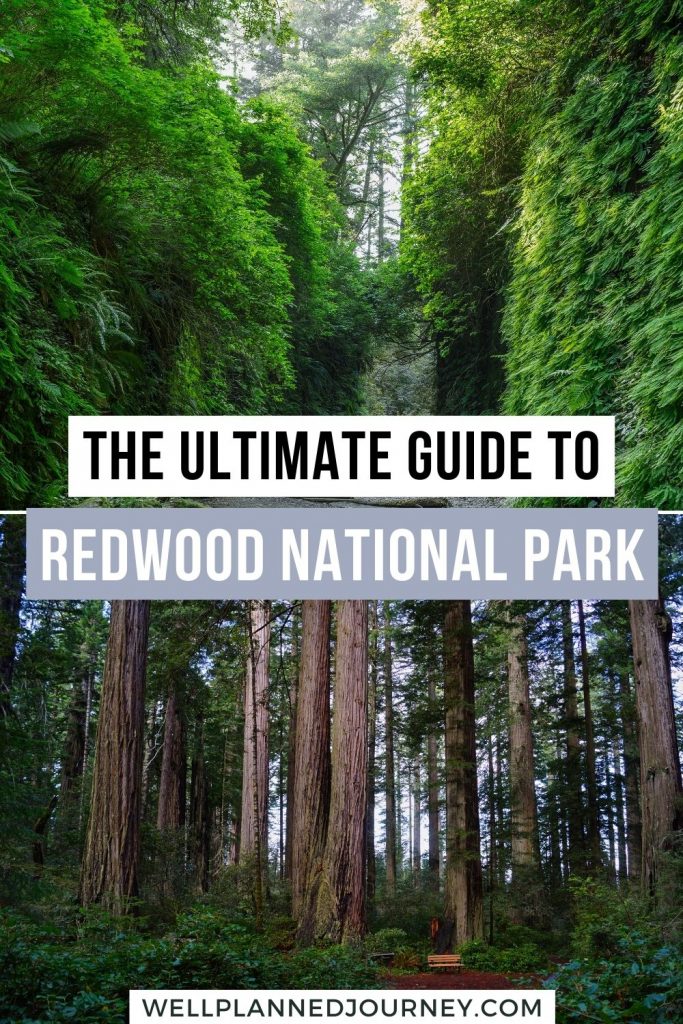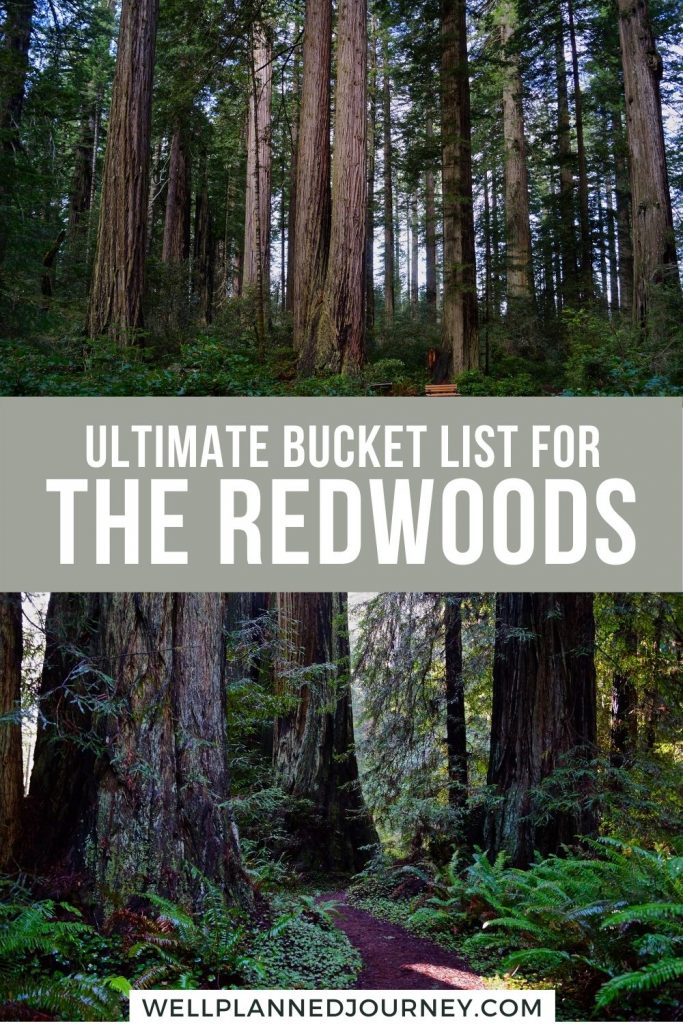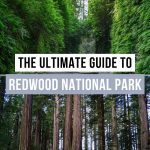Are you planning a trip to Redwood National Park but don’t know where to begin?
Redwood National Park is known for its massive, mysterious coastal redwood trees. This park is home to the world’s oldest redwood groves and the world’s tallest tree.
Walking amongst these giants (many over 2,000 years old) makes you feel tiny and a part of something bigger at the same time.
The ancient mosses and ferns from another era are the reason many movies, like Star Wars and Jurassic Park, chose to film here. But redwoods aren’t the only thing to see when visiting Redwood National Park.
It’s also along the coast of California. Venture to the coastline to see the jagged shores and tide pool-filled beaches. Redwood National Park gives you mystical forests and rugged coastal views all in one trip.
This guide shares everything you need to know to plan a trip to Redwood National Park, including:
- Getting to Redwood National Park
- Where to Stay Near the Park
- What to Pack For Hiking in Redwood
- Best Things to Do in Redwood
- Important Tips for a Successful Trip in 2024
Without further ado, let’s discover the best of Redwood National Park!
This post may contain affiliate links, where I may receive a small commission at no additional cost to you. Read more in this disclosure policy.
Redwood National Park At-A-Glance
Before diving in, here are a few highlights to help you plan your trip:
- Best Time to Visit: Redwood National Park has decent weather all year long thanks to the mild coastal temperatures. The winter months tend to be rainy, so the best months to hike amongst the redwoods are from May to September.
- Where to Stay: If you’re looking to stay in the park, you’ll have to stay at one of the 4 campgrounds in Redwood National and State Parks. Outside the park, book a spot nearby at the Historic Requa Inn in Klamath, California.
- How to Get There: There are small regional airports nearby, but the closest major airports are in Medford (3 hours away) or Sacramento, Oakland, or San Francisco (all 6 hours away). Use Expedia to browse flights and find the best price.
- How to Get Around: The easiest way to get around Redwood is in your own car. Use Expedia to browse deals on rental cars or rent an RV or campervan with Outdoorsy.
- Don’t Forget: Be sure to get an America the Beautiful National Park Pass ahead of time. This $80 pass is valid for 12 months and get you into all 400+ national park sites (including the Redwood State Parks!)
Where is Redwood National Park?
When most visitors think of Northern California, they think of San Francisco. What they don’t realize is there’s a 7-hour drive from San Francisco to the Oregon border.
Redwood National Park is found deep into Northern California along the Pacific Coast just shy of Oregon.
The park is about 6 hours from both San Francisco and Portland, making it the perfect weekend trip from these popular cities.
How Redwood National Park is Organized
Redwood National Park can be a bit confusing. Unlike other parks, it isn’t just a national park. When people refer to Redwood National Park, they generally mean Redwood
National and State Parks. This joint park is a unique partnership between 3 California State Parks and 1 national park:
- Jedediah Smith Redwoods State Park
- Del Norte Coast Redwoods State Park
- Prairie Creek Redwoods State Park
- Redwood National Park
Together, these parks protect half of the world’s old-growth redwoods with nearly 40,000 acres of an old-growth redwood forest. The national park was established in 1968, but the partnered state parks have been protecting the redwoods since the 1920s.
At the southern end of the redwood parks, you’ll find Redwood National Park, the largest of the 4 parks. This federal land protects 71,000 acres and is home to the world’s tallest tree named Hyperion.
To the north, you’ll find the 3 state parks protected by the California government. The largest of the 3, Del Norte Coast Redwoods State Park is half old-growth forest and half coastal trails.
Prairie Creek Redwoods is about half the size of Del Norte and is home to redwood groves where the majestic Roosevelt elk roam. The smallest and farthest north of the 3 state parks is Jedediah Smith Redwoods.
You can get your bearings on the park with this detailed Redwood National Park map.
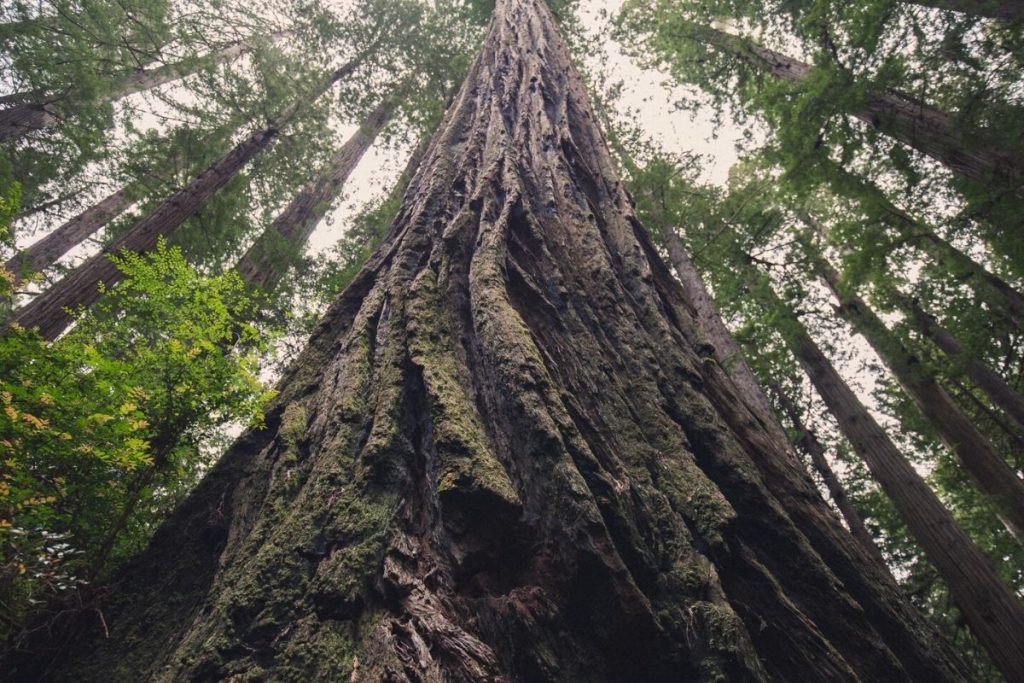
Entrance Fees for Visiting the Redwoods
Since Redwood National and State Parks are managed by the National Park Service and the California State Park service, the national and state parks have different entry fees.
It’s free to enter Redwood National Park! That’s right – the federally managed Redwood National Park doesn’t charge an entry fee and there are no entrance stations.
To enter the 3 California state parks (Del Norte, Jedediah Smith, and Prairie Creek), you’ll need to pay the state park entry fee in some areas. These areas include:
- Entering all developed campgrounds (Jedediah Smith, Mill Creek, Elk Prairie, Gold Bluffs Beach)
- Drive to Gold Bluffs Beach or Fern Canyon in Prairie Creek Redwoods State Park
If you have an America the Beautiful National Park Pass, you won’t be charged entry to the 3 redwood state parks. If you don’t already have a national park pass, I highly recommend one.
Are you visiting multiple national parks in the next year? The America the Beautiful National Park Pass gets you into 400+ national park sites, including all 63 national parks, for 12 months!
Get your national park pass ahead of time for only $80.
There are also several fee-free days each year where the state park day-use fees are waived:
- Martin Luther King Jr. Day in January
- National Park Week in mid-April
- National Park Service Birthday in August
- National Public Lands Day in September
- Veterans Day in November
Getting to Redwood National Park
Redwood National Park isn’t close to any major cities or airports. To get here, you’ll need to road trip or fly into the small, regional airports nearby.
If you’re traveling on a budget, I recommend flying into a major airport, renting a car, and driving to the park. Since the local airports are small with limited flights, they tend to be expensive to fly into.
I use Expedia to find the best flight prices and compare routes. Once you find your flight, you can book directly through Expedia to save money, but still enter your frequent flyer numbers to get points!
If you need a rental car, I also recommend using Expedia to find the best deals across brands like Avis, Hertz, Enterprise, Budget, and more.
Closest Airport to Redwood National Park
Check for flights into these larger, international airports:
- Rogue Valley International-Medford Airport (MFR) – 3-hour drive
- Sacramento International Airport (SMF) – 6-hour drive
- San Francisco International Airport (SFO) – 6-hour drive
- Oakland International Airport (OAK) – 6-hour drive
If you choose to fly into the local airports, you can choose between:
- California Redwood Coast-Humboldt County Airport (ACV) – 30-minute drive
- Del Norte County Regional Airport (CEC) – 30-minute drive

Getting to Redwood National Park from San Francisco
If you’re flying into San Francisco or Oakland, I highly recommend making a long road trip out of your journey to the Redwoods. Drive the scenic stretch of Highway 1 (also called the Pacific Coast Highway) up to the park instead.
This scenic route will take you roughly 9 hours without stops – it’s a long day of driving, but so worth it!
Alternatively, you can take the interior Highway 101 the entire way instead. This route saves you a few hours but isn’t nearly as scenic.
Read More: 20 Best Stops on the Pacific Coast Highway
Getting to Redwood National Park from Oregon
If you choose to fly into Portland, you can catch scenic parts of the Oregon Coast on your way down to Redwood National Park. Head south on I-5 from Portland, cutting over to the Pacific Coast Highway (also called Highway 101 in Oregon) in Albany, Oregon.
This route adds about 2 hours to your trip.
If you’re flying into Medford, consider looping in a side trip to Crater Lake before or after your trip to Redwood National and State Parks.
Getting Around Redwood National and State Parks
There is no shuttle service in Redwood National and State Parks. The best way to get around these parks is by driving, either in your vehicle or a rental car.
In the summer, trailhead parking can fill up for popular trails like Fern Canyon. The best way to beat crowds is to visit in the off-season and start your days early.
Are you planning a national park trip but don’t know where to start? Get my free 28-page national park ebook where I break down everything you need to know to visit all 63 USA national parks.
Download your free ebook here.
Where to Stay at Redwood National Park
Unlike other national parks, Redwood National and State Parks don’t have any lodges or hotels inside the park boundaries. To stay inside the park, you’ll need to stay at one of the park’s 4 campgrounds.
If camping isn’t your style, consider staying in a hotel or Airbnb in one of the nearby towns.
This interactive map can help you search all the available hotels and rental properties near Redwood National Park! Simply scroll and click the map below to see what is available!
Hotel Lodging in Redwood National Park
There are several gateway towns near the redwoods that provide hotel and motel accommodations.
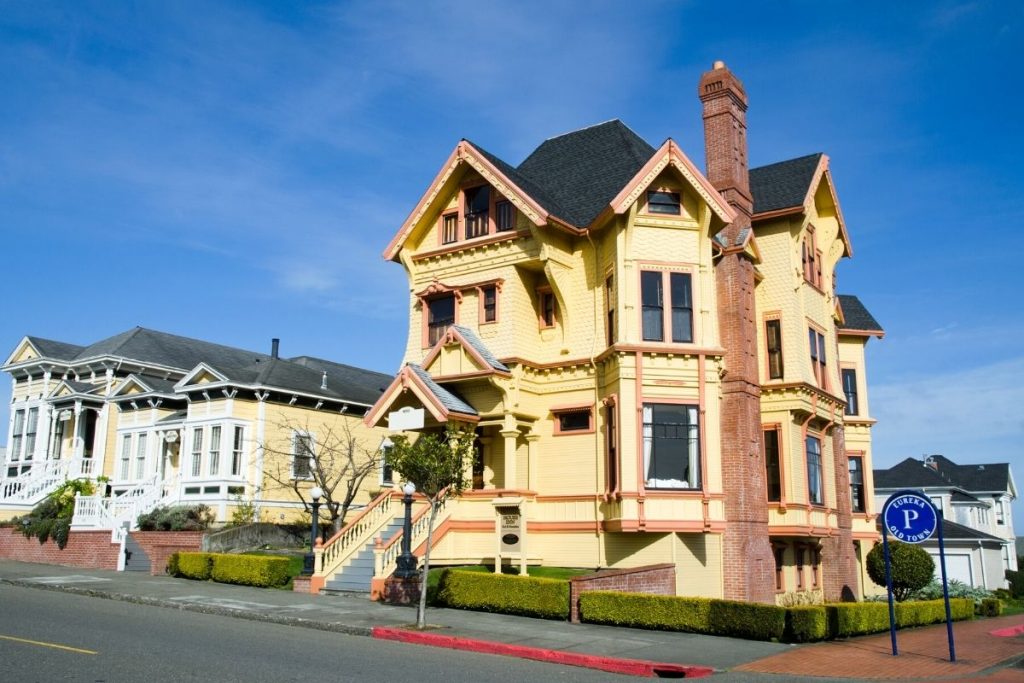
Eureka is the largest town near Redwood National Park. It’s the largest coastal town between San Francisco and Portland. Eureka is a quaint town with many historic buildings.
In Eureka, you’re 45 minutes from the center of the park at Kuchel Visitor Center.
The best places to stay in Eureka include:
- Carter House Inns for a more luxurious stay in a historic quarter of Eureka
- Eureka Inn for a mid-range, quaint stay in the heart of Eureka
Klamath is the closest town to the heart of Redwood National and State Parks. While there are fewer options here compared to Eureka, there are still some great choices, including chain hotels for those looking to use hotel points!
The best places to stay in Klamath include:
- Holiday Inn Express for a budget stay near the parks
- Historic Requa Inn for a quaint B&B style stay near the redwoods

Crescent City lies at the northern edges of the parks, just past Del Norte Coast Redwoods State Park. It’s one of the last towns you hit before the Oregon border and is where you’ll find the best budget accommodations near Redwood.
Crescent City is roughly an hour north of Kuchel Visitor Center.
The best places to stay in Crescent City include:
- Lighthouse Inn for a budget, motel-style stay near the harbor
- Oceanview Inn for a no-frills, budget hotel near the heart of town
Vacation Rentals & Airbnbs Near the Park
The region around Redwood National and State Parks also has home rentals and private campgrounds for those looking for a bit more space.
One of the best rentals near the parks is Elk Meadow Cabins in Orick, CA. These cabins are in the heart of the park, only minutes to top hiking trails and scenic drives. These cabins are known for the Roosevelt Elk that roam nearby.
You’ll have a good chance of spotting some if you stay here! Elk Meadow Cabins offers an array of lodging, from studio to 3 bedroom cabins.
For more unique stays and cabins near the park, check out Airbnb, VRBO, or Hipcamp.
Camping in Redwood National Park
Since Redwood National and State Parks doesn’t have any lodging inside the park boundaries, you’ll need to stay at one of the park’s campgrounds if you want to stay in the park.
Redwood offers both developed campgrounds and backcountry camping.

Developed Campgrounds
The park’s 4 developed campgrounds are spread across the 3 redwood state parks (there isn’t a campground in Redwood National Park!). All 4 of the park’s campgrounds are reservable through Reserve California.
While reservations aren’t quite as competitive as other more popular national parks, they will still fill up months in advance in the summer. I always recommend making a campground reservation as soon as you’ve finalized your trip.
There are 300 campsites spread across the 4 campgrounds. All have basic amenities like restrooms with showers, food lockers, and fire pits.
For more details on each of the campgrounds below, check out the Redwood National Park Camping page.
- Jedediah Smith Campground
- Park: Jedediah Smith Redwoods State Park
- Open: All year
- Campsites: 86
- RV Accommodations: Max 25 feet; No hookups
- Known for: Campsites among old-growth redwoods near the Smith River
- Mill Creek Campground
- Park: Del Norte Coast Redwoods State Park
- Open: May to September
- Campsites: 145
- RV Accommodations: Max 28 feet; No hookups
- Known for: Young, mossy redwoods and nearby hiking trails
- Elk Prairie Campground
- Park: Prairie Creek Redwoods State Park
- Open: All year
- Campsites: 75
- RV Accommodations: Max 27 feet; No hookups
- Known for: Roosevelt elk roaming through the old-growth redwoods nearby
- Gold Bluffs Beach Campground
- Park: Prairie Creek Redwoods State Park
- Open: All year
- Campsites: 26
- RV Accommodations: Max 24 feet (no trailers); No hookups
- Known for: Only park campground along the ocean and near Fern Canyon
All campgrounds provide a unique experience camping amongst the redwoods and California coast. Pick a campground near your favorite activities, or move around to different campgrounds to take in all the park has to offer!
Best Time to Visit Redwood National Park
Thanks to the nearby Pacific Ocean, Redwood National Park is open all year with temperatures staying between 50 and 60 degrees year-round.
The summer is dry but foggy and winter is rainy, reminiscent of pacific northwest weather.
In the summer, rain is rare – typically only 2-5 days per month. Summer also brings low-hanging fog from the Pacific Ocean. This fog provides the redwoods with much-need moisture for growth.
The rest of the year averages around 17 rainy days per month.
Redwood National Park gets most of its visitors between May and September during the dry season. That said, crowds never reach insanely high numbers like in other parks like Yosemite and Zion.
But if you prefer complete solitude, visit during the winter months – you’ll have many of the trails to yourself!
What to Pack to Visit Redwoods
With cool temperatures and little to no cell service, packing layers and safety gear is essential for any trip to Redwood National Park. Here are the items I recommend packing for your trip:
- Binoculars – There’s plenty of wildlife to see in Redwood, but the most impressive is the Roosevelt Elk. It’s always important to give wildlife plenty of space, so bring along a pair of binoculars to get a closer view! I have this inexpensive pair of compact binoculars from Amazon.
- Down Jacket or Fleece – Warm layers like a down jacket or fleece pullover are essential. I like the Arc’teryx Cerium LT Down or Patagonia Better Sweater.
- Waterproof Rain Jacket – If you’re visiting in the rainy months, be sure to pack a rain jacket with Gore-tex (a waterproof material). I have the REI XeroDry GTX.
- Lightweight Hiking Shoes – If you stop for a hike on the beach, you’ll want lightweight shoes with solid traction. I like the Altra Lone Peak 4.5 Trail Runners for short beach hikes.
- The 10 Essentials – If you’re heading out for one of the many hikes in the area, be sure to bring along the 10 hiking essentials that keep you safe on the trail. For more on the 10 essentials, check out my hiking gear guide.
- Roadside Assistance Kit – With little cell service, you’ll want to be prepared for unexpected car issues. Look for a roadside kit with jumper cables and repair tools like this emergency roadside kit from AAA.
Looking for more tips on what to pack for your trip? Check out my guides on the best hiking gear, what to pack for a road trip, and essential camping gear for all my favorite gear picks and tips to make packing for your trip a breeze!
How Many Days to Visit Redwood National Park?
There’s a wide array of things to do in Redwood National Park, from hikes to scenic drives. While you could get a glimpse of the park in only one day, I highly recommend spending at least 2 to 3 days in the park to see the highlights.
For a longer trip, consider combining your trip to Redwood with a scenic drive of the Lost Coast or a road trip to Oregon.
Read More: 25 Best Things to Do in Redwood

Highlights of Visiting Redwoods National Park
There’s plenty of amazing things to do in all 4 parks that make up Redwood National and State Parks. Below you’ll find the highlights and best things to do in each park.
Redwood National Park
- Driving Bald Hills Road
- Hiking Lady Bird Johnson Grove
- Hiking Tall Trees Grove (by permit only)
Prairie Creek Redwoods State Park
- Camping at Gold Bluff Beach
- Hiking Fern Canyon
- Driving Newton B. Drury Scenic Parkway
- Seeing Roosevelt elk in Elk Prairie
- Driving Coastal Drive Loop to Klamath Beach and High Bluff Overlook
Del Norte Coast Redwoods State Park
- Hiking Damnation Creek Trail
- Exploring tidepools at Enderts Beach
- Hiking or biking the Coastal Trail
Jedediah Smith Redwoods State Park
- Driving Howland Hill Road
- Hiking Stout Memorial Grove
- Paddling or swimming in the Smith River
Best Things to Do in Redwood National Park
While the best way to see the redwoods is up close on a hike, there’s plenty of activities for every type of national park lover.
From hiking to biking to scenic drives, you’ll find no shortage of things to do on a 2-3 day trip to Redwood National Park.
Redwood National Park Hiking
Many of the best hikes in the park lead you to spectacular redwood views without having to stray too far from the road. These popular trails vary in difficulty from easy to strenuous for those of all ability levels.
Read More: 12 Best Hikes in Redwood National Park
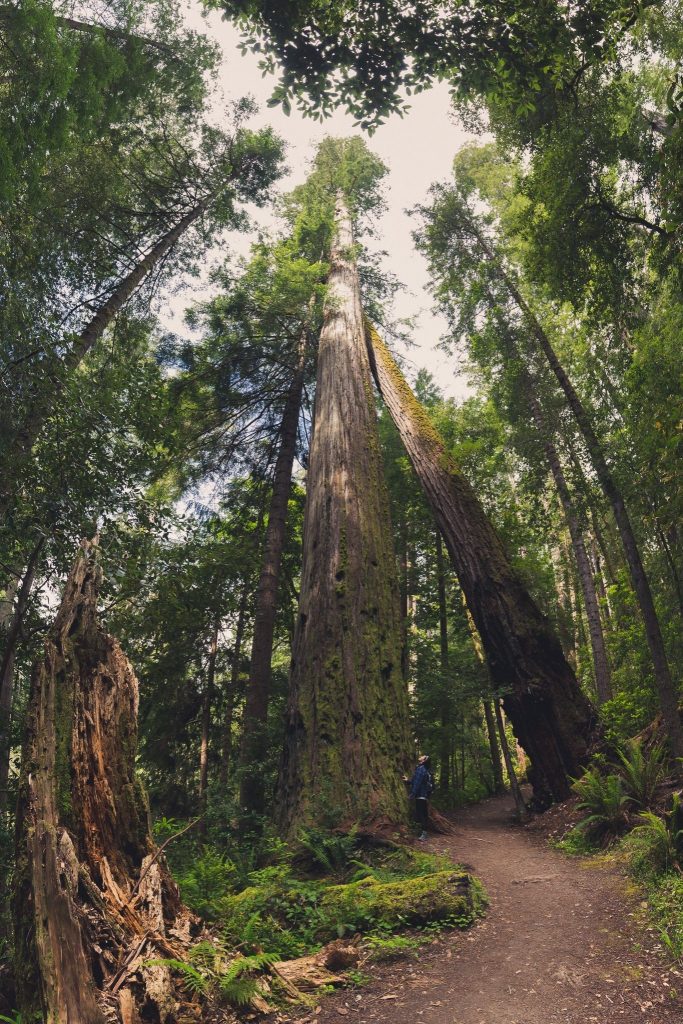
Tall Trees Grove
- Park: Redwood National Park
- Distance: 3.3 miles
- Elevation: 748 feet
- Difficulty: Moderate
- Check out this hike on AllTrails
This is hands-down the best trail in the park to explore the giant coastal redwoods up close. Tall Trees Grove is aptly named – it’s home to the world’s tallest tree, Hyperion, which stands at 379 feet tall.
To put it in perspective, that’s taller than the Statue of Liberty and more than half the height of the Seattle Space Needle!
The exact location of Hyperion is kept secret to avoid over-tourism and damage to the surrounding redwood trees.
To limit the crowds, hikers are required to get a free permit in advance. Generally, permits aren’t that hard to get if you plan. Visitors can apply for the online permit here, from 4 weeks to 48 hours out.
I recommend applying as far in advance as possible to ensure you secure a permit.
You start your hike at the Tall Trees trailhead and descend 800 feet over 1.5 miles to the forest floor, along Redwood Creek. Walk amongst the old-growth redwoods on a one-mile loop before returning to the trailhead.
While this is only a 4-mile hike, you should budget at least half a day. Tall Trees Grove has countless trees over 350 feet. Walk slowly, crane your neck, and soak up the feeling of being a tiny ant on the forest floor.
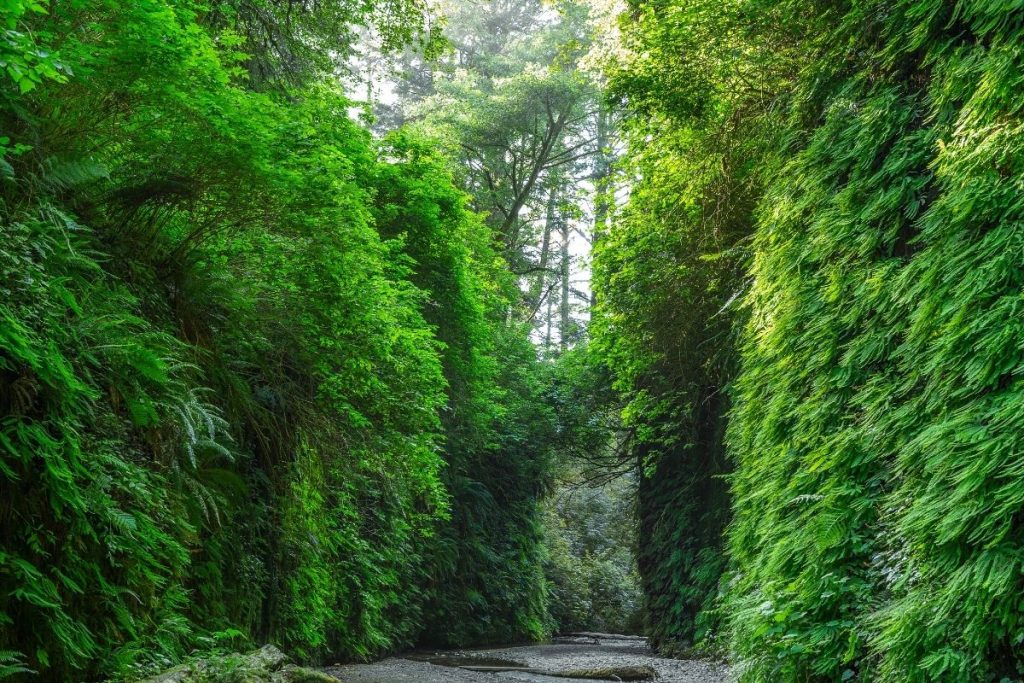
Fern Canyon
Fern Canyon is, as you might expect, a 50-foot canyon covered in ancient, prehistoric-looking ferns. So prehistoric in fact that this trail was a filming location for Jurassic Park 2.
Some of these ferns are part of an ancient species, dating back 325 million years. The trail winds along a creek bed through the canyon with spectacular views.
Hikers can reach Fern Canyon two ways: on the 12-mile James Irvine Loop Trail or the short 1-mile loop from Davison Road.
To reach Fern Canyon from the James Irvine Trail:
- Park: Prairie Creek Redwoods State Park
- Distance: 13.0 miles
- Elevation: 1,614 feet
- Difficulty: Moderate
- Check out this hike on AllTrails
This loop is the most popular of the longer-distance hikes in the park. You’ll cross creeks and pass through old-growth redwood groves as you hike out to Fern Canyon.
To complete this hike as a loop, take the Miner’s Ridge Trail on the way back to the Prairie Creek Visitor Center.
To reach Fern Canyon from Davison Road:
- Park: Prairie Creek Redwoods State Park
- Distance: 1.1 miles
- Elevation: 118 feet
- Difficulty: Easy
- Check out this hike on AllTrails
The shorter route to Fern Canyon is found at the end of the unpaved Davison Road past Gold Bluffs Beach. This 10-mile dirt road can be difficult to traverse after a rainstorm.
Check with park rangers at the Kuchel Visitor Center before attempting to drive Davison Road if you don’t have a high clearance vehicle.
From the trailhead, it’s a short walk along the creek bed to explore Fern Canyon.
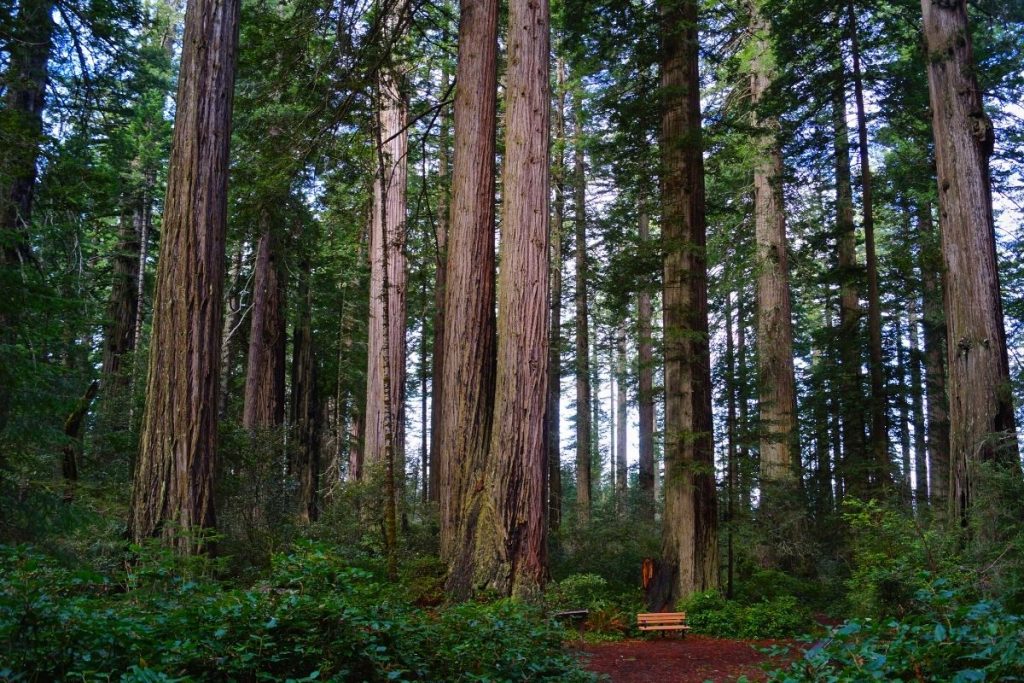
Lady Bird Johnson
- Park: Redwood National Park
- Distance: 1.3 miles
- Elevation: 73 feet
- Difficulty: Easy
- Check out this hike on AllTrails
This short trail through a popular redwood grove is one of the most popular groves in the park. The grove gets its name from the former first lady of the United States.
As you hike, you’ll pass through forests of redwoods and other evergreen coniferous trees.
Educational signs are scattered along the trail, making this the perfect trail for the family to learn about the redwoods.
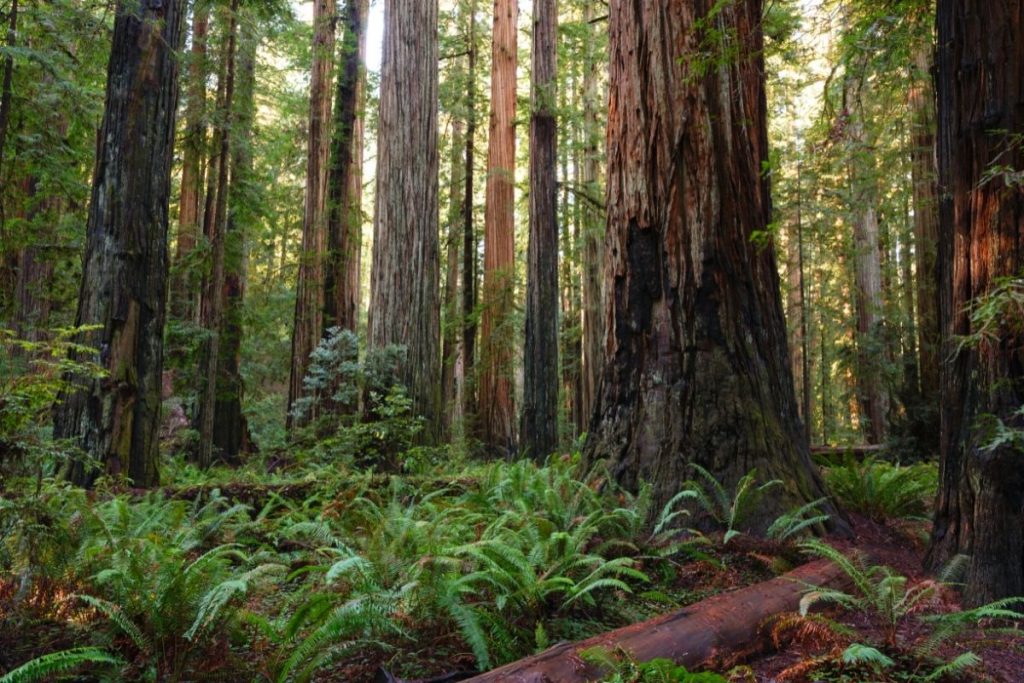
Stout Memorial Grove
- Park: Jedediah Smith Redwoods State Park
- Distance: 0.7 miles
- Elevation: 32 feet
- Difficulty: Easy
- Check out this hike on AllTrails
Stout Grove is home to a 44-acre grove of old-growth redwood trees in the heart of Jedediah Smith Redwoods State Park along the Smith River.
Since many of the trees here are hundreds and thousands of years old, it’s not uncommon to see redwoods over 300 feet tall in this grove.
This trail is easy and family-friendly at only 0.5 miles. You can access the trailhead either from the end of the scenic drive along Howland Hill Road or from Jedediah Smith Campground (perfect for if you’re camping there!).

Prairie Creek and Foothill Loop
- Park: Prairie Creek Redwoods State Park
- Distance: 2.6 miles
- Elevation: 95 feet
- Difficulty: Easy
- Check out this hike on AllTrails
This loop trail is a perfect introduction to the old-growth redwoods in this region. Start your hike on the popular Prairie Creek trail.
Walk amongst the redwoods and along Prairie Creek. After following the Prairie Creek trail, reunite with Newton B. Drury Scenic Parkway.
Across the road, follow the trail to Big Tree Wayside – one of the biggest trees in Prairie Creek Redwoods State Park. After checking out the big tree, follow the Cathedral Tree Trail back to the Prairie Creek Visitor Center.
Keep your eyes peeled near the visitor center for the area’s famous Roosevelt elk!
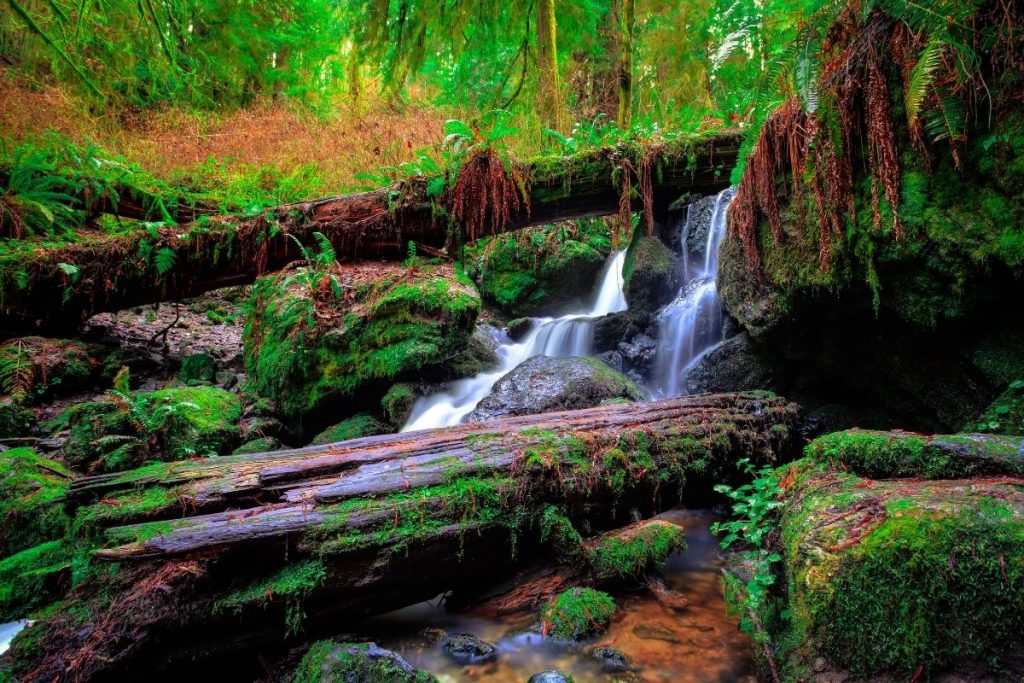
Trillium Falls
- Park: Prairie Creek Redwoods State Park
- Distance: 2.6 miles
- Elevation: 433 feet
- Difficulty: Moderate
- Check out this hike on AllTrails
The lush redwood forests are surrounded by ocean and rivers, so it’s only natural that you’d find a waterfall nestled in the redwoods. The short, family-friendly trail takes you through an old-growth redwood forest to the 10-foot tall Trillium Falls.
But this trail has more than just waterfalls and redwoods! You’ll also find flowers, ferns, and fir trees. The trail to Trillium Falls also passes through an area that is home to the Roosevelt Elk herds that live in the park.
You have a good chance of spotting one on your hike – just don’t forget your binoculars!

Boy Scout Tree Trail
- Park: Jedediah Smith Redwoods State Park
- Distance: 5.3 miles
- Elevation: 938 feet
- Difficulty: Moderate
- Check out this hike on AllTrails
The Boy Scout Tree Trail is one of the more challenging hikes in the park. If you’re looking for solitude amongst the redwoods, this is the trail for you! The 5+ mile round trip trail passes through groves of giant redwoods with forest floors covered in ferns.
You’ll feel just like you’re walking on Endor with the Ewoks (they filmed the movie here!).
The trail starts off the scenic dirt drive, Howland Hill Road in the northern area of the park.
Scenic Drives in Redwood National Park
Unlike many national parks, scenic views in Redwood National Park can be found just off the road. If you’re short on time, scenic drives are the perfect way to explore the park.
Read More: 25 Things to Do in Redwood National Park
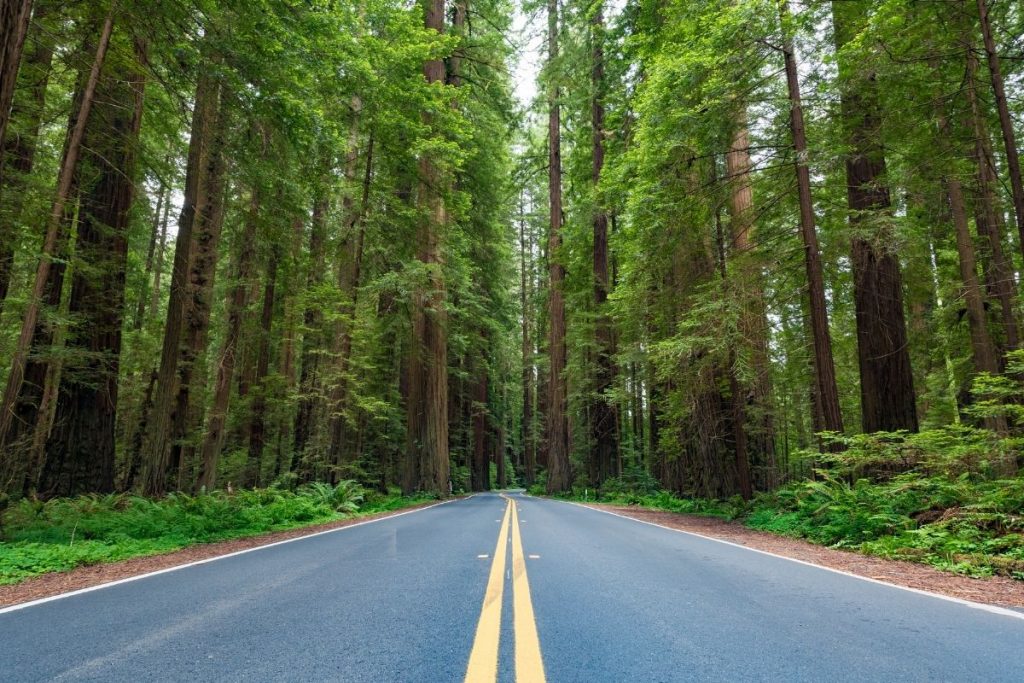
Newton B. Drury Scenic Byway
- Park: Prairie Creek Redwoods State Park
- Distance: 10 miles
This short, paved scenic drive takes you through the redwoods of Prairie Creek Redwoods State Park. Except for Avenue of the Giants, this is one of the only places in the world where visitors can drive through the heart of an old-growth redwood grove.
If you only have time for one scenic drive, make it this one!
As you drive, you’ll see skyscraping redwoods and plenty of short trails along the road for a closer look. The Ah-Pah Trail and Big Tree Wayside Trail take you up-close and personal with the park’s old redwoods.
Keep your eyes peeled for Roosevelt elk – a rare breed of elk that can weigh over 1,000 pounds. These elk live in herds in Prairie Creek Redwoods State Park.
Newton B. Drury Scenic Parkway runs parallel to Highway 101 making it easily accessible. You can navigate the road starting at either the north end or the south end.
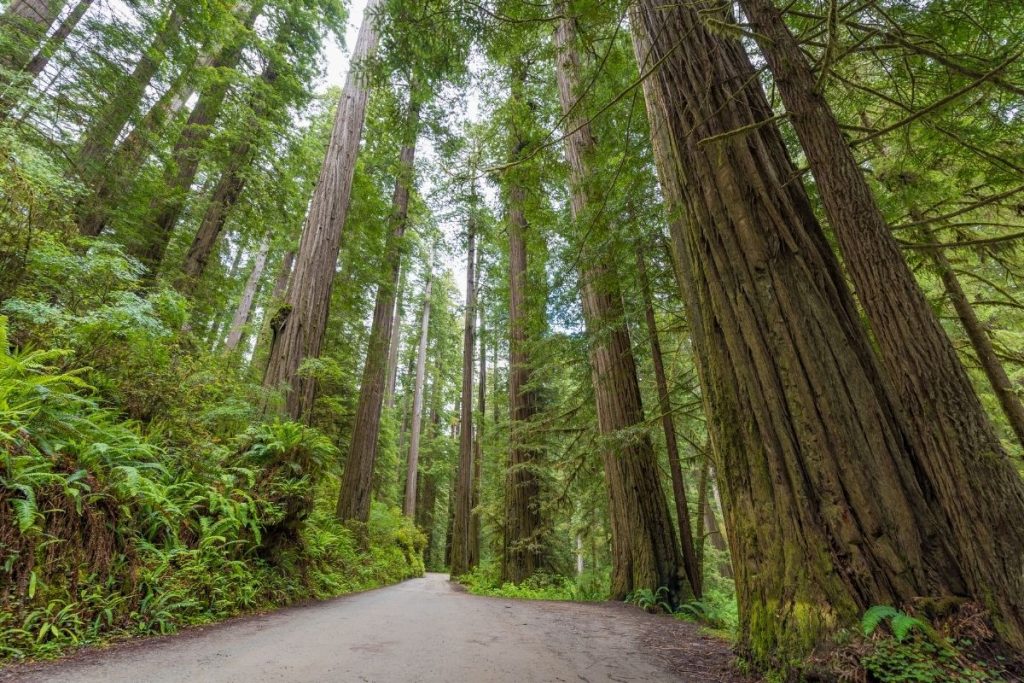
Howland Hill Road
- Park: Jedediah Smith Redwood State Park
- Distance: 10 miles
At the northern end of the park, Howland Hill Road takes you through the heart of Jedediah Smith Redwoods State Park. Your car squeezes between giant redwoods on an unpaved, dirt road.
There are a few turnoffs and trailheads scattered along the drive.
The short 0.5-mile Stout Grove or 5.5-mile Boy Scout Tree Trail is a popular break from the scenic drive.
Start your drive near Crescent City on Highway 101 and take Elk Valley Road until it hits Howland Hill Road. Continue along the road as Howland Hill Road turns into Douglas Park Road.
The scenic drive ends as the road meets Highway 199, near Hiouchi Visitor Center.
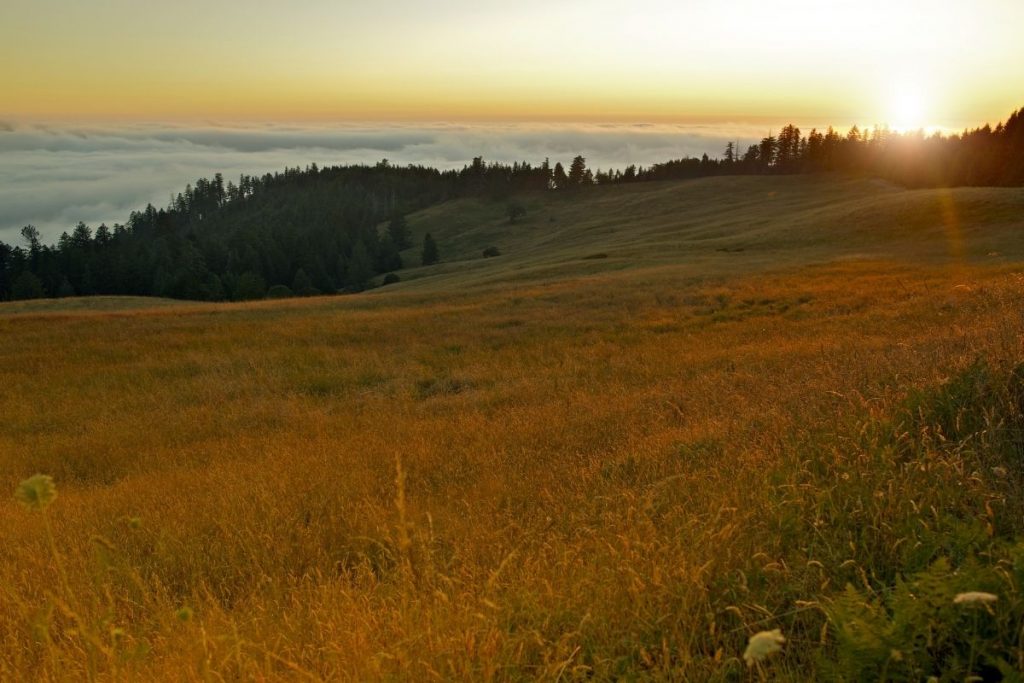
Bald Hills Road
- Park: Redwood National Park
- Distance: 17 miles
For a change of pace from the old-growth redwood groves, consider driving the Bald Hills Road scenic drive. The drive passes through meadows and open prairies high above the redwood forests.
Along the drive, Redwood Creek Overlook provides excellent, sweeping views of the surrounding valleys and forests. In the spring, the area is home to beautiful wildflowers.
Popular trails like Lady Bird Johnson Grove and Tall Trees Trail are found off sections of Bald Hills Road.
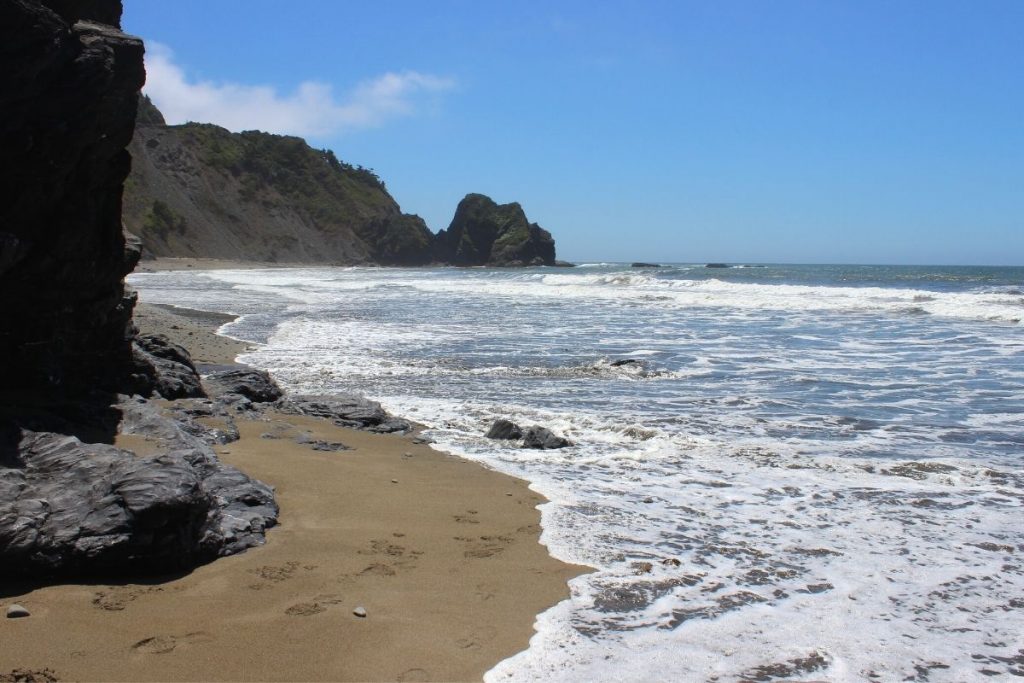
Enderts Beach Road
- Park: Del Norte Coast Redwoods State Park
- Distance: 2.25 miles
For a quick drive out to a beautiful ocean overlook, head along Enderts Beach Road. The short drive takes you out to Crescent Beach Overlook, just a few minutes away from downtown Crescent City.
The overlook provides sweeping views of the Pacific and Enderts Beach.
You’ll also find the trailhead for the Coastal Trail, a popular backcountry camping route, off of Enderts Beach Road.
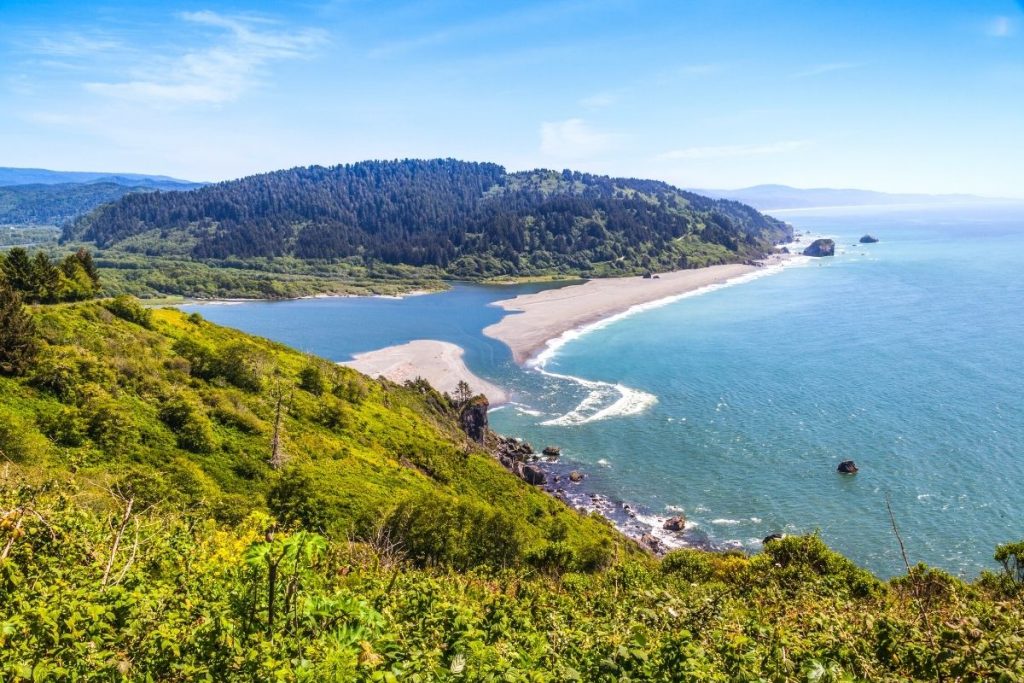
Klamath Beach Road
- Park: Del Norte Coast Redwoods State Park
- Distance: 6.5 miles
The drive along Klamath Beach Road takes you along the coast into the northern section of the park. Best driven around sunset, you’ll see the last light of the day highlight the crashing waves of the Pacific Ocean below.
It’s a great way to end your day with a picnic and a bottle of wine. From December to April, you may be able to spot migrating whales passing through!
Start your drive on Highway 101 near Klamath. Turn off 101 onto Klamath Beach Road. Parts of this route are one-way so you must follow the route clockwise. Turn left onto Alder Camp Road and stop at High Bluff Overlook.
You’ll pass an old World War II radar station, disguised as a farmhouse to avoid detection. Take Klamath Beach Road back to Highway 101 to finish your scenic drive.
Biking the Redwoods
Redwood National and State Parks offer plenty of bike trails throughout the park, ranging from flat, paved paths to more strenuous roads. You can read more about biking in the redwood parks here.
One of the best bicycling opportunities is on the Newton B. Drury Scenic Parkway in Prairie Creek Redwoods State Park. Newton B. Drury Scenic Parkway offers “Hike and Bike” days on the first Saturday of each month from October to May.
On these days, the 10-mile scenic drive is closed to vehicle traffic and open to hiking, biking, and skating only.
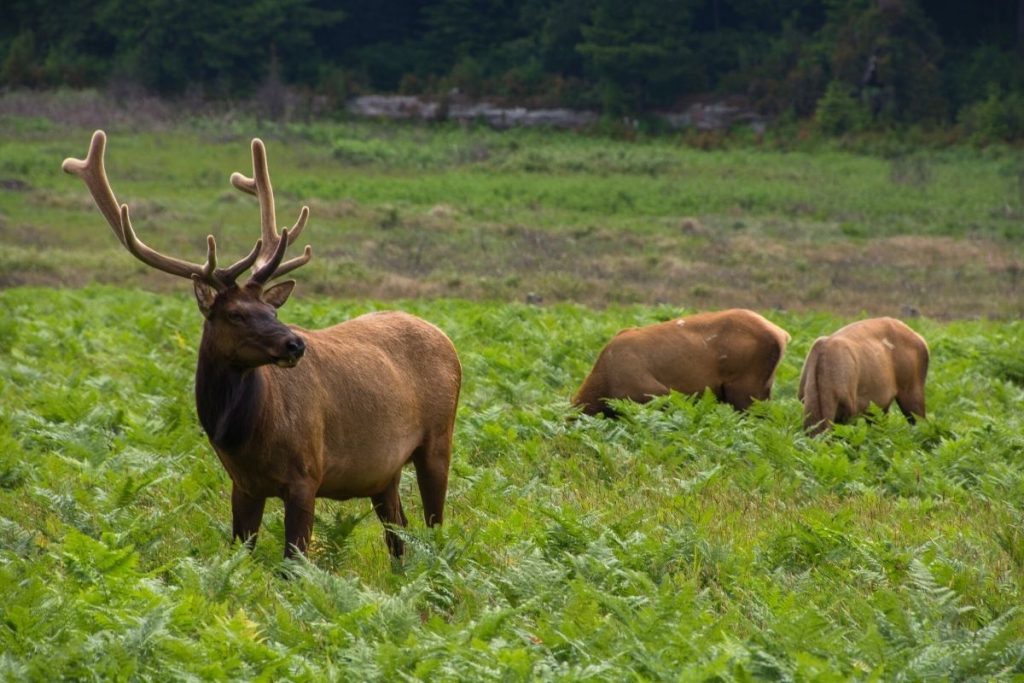
Wildlife in Redwood National Park
There’s plenty of opportunities to spot wildlife in Redwood National and State Parks! Thanks to the park’s location along the Pacific Ocean, there are unparalleled opportunities to see marine life.
Plus, the park is home to the impressive Roosevelt Elk, some of the largest mammals in the deer family.
Here’s some of the best wildlife you can see in Redwood:
- Roosevelt Elk live in herds in Prairie Creek Redwoods State Park. The best times to spot the elk are during mating season in the fall and calving season in May and June. Newton B. Drury Scenic Drive, Gold Bluffs Beach, and Ball Hills Road are all great places to spot elk. Just remember to give them plenty of distance and watch from a safe distance.
- Whale Watching is a popular activity in the park from November to December and March to April. Some of the best viewpoints for whale watching include Klamath River Overlook, Crescent Beach Overlook, High Bluff Overlook, and Gold Bluffs Beach.
- Tidepools provide unique opportunities to spot small marine life, like sea anemones and starfish. One of the best places to search for tidepools is at Enderts Beach, a short walk down the Coastal Trail from Crescent Beach Overlook.
Redwood National Park Backpacking
There are 7 designated backcountry camping areas across the 4 parks, plus additional opportunities for dispersed camping. Visiting these campgrounds is a great way to escape others and have a trail all to yourself.
Backcountry camping in Redwood National Park requires a free permit. These permits are issued online only. Visitors can apply for a permit anywhere from 4 weeks in advance to no later than 48 hours out.
For more information on backcountry permits in Redwood, read more here.
If you plan to request a backcountry permit, use Redwood’s Backcountry Trip Planner to select a trail and camping area ahead of time.
Nearby Parks for After Visiting Redwood National Park
Tucked away in Northern California, Redwood National Park is secluded from major cities. But there’s plenty of additional opportunities to make a road trip out of your trip to the redwoods.
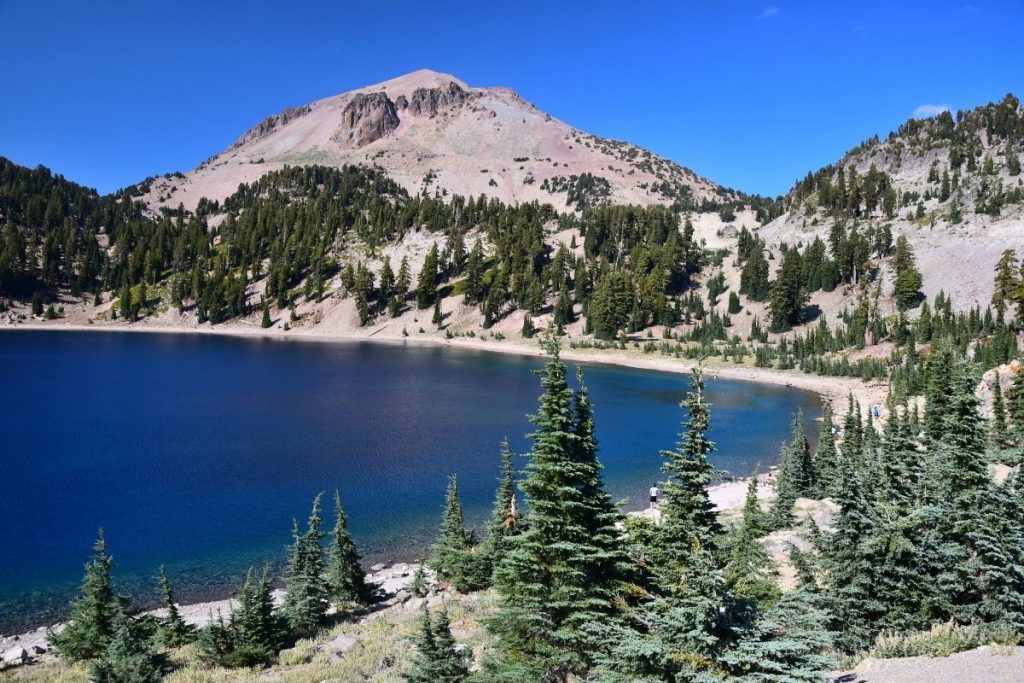
Lassen Volcanic National Park
Located 4 hours from Redwood National Park, you’ll find Northern California’s other national park: Lassen Volcanic National Park.
A visit to Lassen is the perfect way to explore California’s volcanic activity on hiking trails and camping along the serene waters of Manzanita Lake.
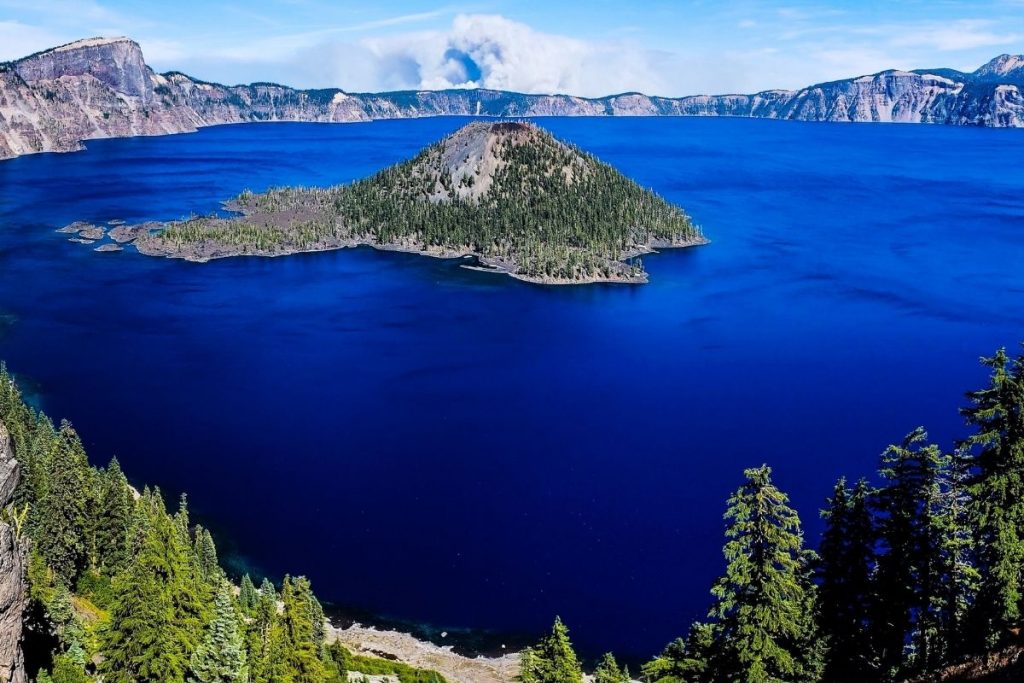
Crater Lake National Park
A 4-hour drive north from Lassen Volcanic along the famed Volcanic Legacy Scenic Highway takes you to Crater Lake, easily one of the most impressive natural wonders in the Pacific Northwest.
Driving directly from Redwood, it takes about 5.5 hours to get to Crater Lake.
Crater Lake was formed when a volcano imploded over 7,000 years ago. The massive lake holds some of the bluest, purest, clear water in the world. The scenic Rim Drive at Crater Lake belongs at the top of your bucket list.
Learn more about the best things to do in Crater Lake, including the best hikes and the best camping spots near Crater Lake.
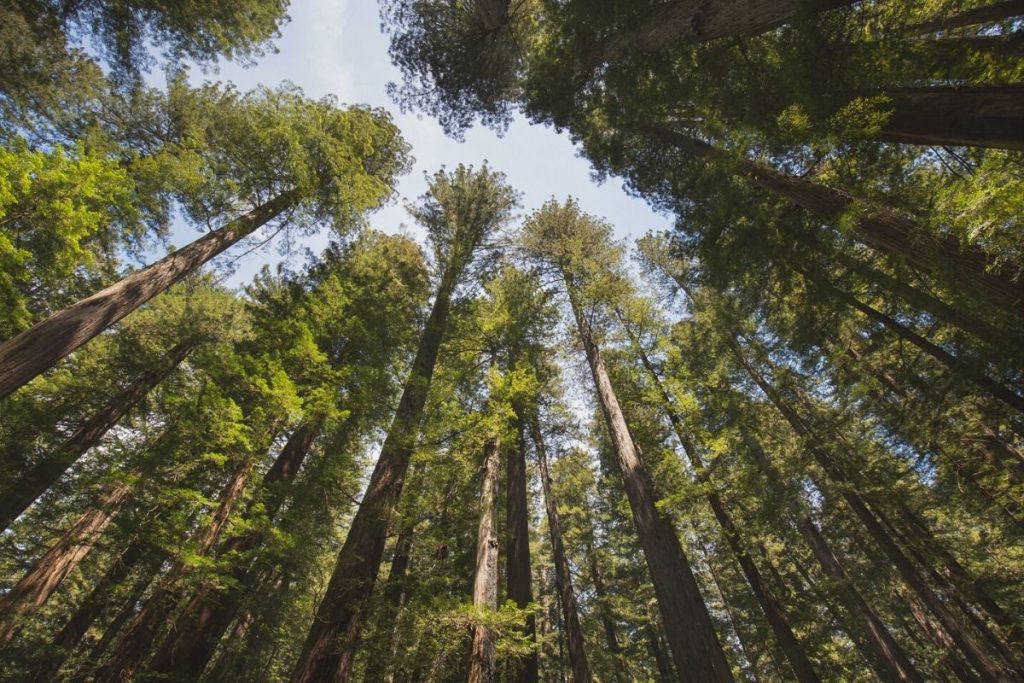
Avenue of the Giants
One of the most popular scenic drives through redwoods lies a few hours south of Redwood National Park in Humboldt Redwoods State Park. The popular drive called Avenue of the Giants runs parallel to Highway 101.
If you’re traveling to the redwoods from the Bay Area, this scenic drive is the perfect detour. Don’t miss exploring the Dyerville Giant and a short hike along the Founder Grove Loop trail.
Start this 31-mile scenic drive at either the southern entrance, off Highway 101 exit 645, or the northern entrance, off Highway 101 exit 674.
At the beginning of your drive, stop to pick up a self-guided auto tour map from the information stand.

Lost Coast
The Lost Coast is one of the world’s best backpacking destinations. While the only way to truly access this long stretch of rugged California coastline is on foot, driving Mattole Road can give you a sneak peek.
Mattole Road starts in the quaint town of Ferndale, about 20 miles south of Eureka.
Follow the narrow, windy Mattole Road down to Black Sands Beach. While this stretch of road is only 20 miles, drive slowly and take at least an hour to soak in the views.
Continue along Mattole Road, through small towns like Petrolia. You’ll pass through Humboldt Redwoods State Park, near Avenue of the Giants, and eventually rejoin Highway 101.
Budget at least half a day for this scenic drive through the Lost Coast. Want to know more about the Lost Coast? I have an entire guide on taking a Lost Coast Road Trip!
Read More: Ultimate Lost Coast Road Trip Guide
Tips for Visiting the Redwoods
- The America the Beautiful National Park Pass covers your entry to all 4 parks in Redwood National and State Parks. Plus, with the annual park pass, you’ll get entry to all 60+ national parks and 400+ monuments, historic sites, and more. Get your national park pass for only $80 here.
- There are no restaurants or shops inside the park. You’ll need to plan ahead and pack lunches and snacks to keep you going while exploring the parks. Just outside the parks in Trinidad, Orick, and Klamath, you’ll find both restaurants and lodging options.
- Google Maps is known to be unreliable in this area. Instead, rely on the official park maps for navigating to and from trailheads if Google Maps seems to be sending you in a weird direction.
- Always check road and trail conditions for heading out. Rain, fallen trees, and landslides are rapidly changing conditions in the park. Before you begin any of the scenic drives or hikes in the region, check trail conditions on the park website or with a ranger at any of the visitor centers.
- Fill up on gas. There are no gas stations in the park. Before starting any of the scenic drives or driving to a trailhead, make sure your car has plenty of gas to make it both there and back.
- Always carry rain gear. Even if you’re visiting in the drier Summer season, rain can still come at any time. Be prepared by carrying a rain jacket or poncho in your hiking day pack. This is one of the 10 essentials you should carry during every hike.
- Book accommodations in advance. Most campsites and hotels in the area allow for advance online reservations. To save yourself the hassle of trying to find a place to stay without cell service, book in advance.
- Download all reservation information offline. Once you’ve made your reservations, be sure to save PDF versions of the confirmation emails in your Google Drive or bring along a printed version.
- Download maps offline in the Google Maps app. This will allow you to navigate without cell service. I prefer to download the entire area I’ll be passing through. It doesn’t take up much space and is a great safety precaution.
Frequently Asked Questions About Redwood National Park
How many days do you need in Redwood National Park?
To see the park’s highlights, you’ll need around 2 to 3 days. To see all that Redwood National Park has to offer, I recommend spending a week and visiting nearby destinations like the Pacific Coast Highway and other national parks.
What is the best time of year to visit the redwood forest?
Temperatures are warm most of the year thanks to the coastal climate. For dry, sunny weather visit during the summer from June to September. To avoid crowds, consider visiting in May or October instead.
Is Redwood National Park worth visiting?
Redwood National Park is absolutely worth visiting. With plenty of scenic drives and hikes, the park offers something for people of all ability levels and interests. The park is home to the world’s oldest redwood groves and the world’s tallest tree.
What should you not miss in Redwood National Park?
Some of the can’t miss activities in Redwood National Park include hiking Tall Trees Grove and Fern Canyon, driving Newton B. Drury Scenic Highway, and spotting the area’s native Roosevelt Elk.
Final Thoughts on Visiting Redwood National Park
Redwood National Park is a dream for those looking to avoid the crowds at other busy California parks. The redwood trees are some of the oldest, and tallest, living things. The serenity of walking amongst these giant beings is unexplainable.
If you’re only in Redwood National Park for the weekend, don’t miss:
- Tall Trees Grove – this moderate hike is accessible by permit only and is home to the world’s tallest tree, Hyperion.
- Fern Canyon – explore a prehistoric fern-covered canyon via a 12-mile forested hike or a 1-mile loop off the unpaved Davison Road
- Coastal Drive – take this scenic drive at sunset to see the sky light up over the Pacific Ocean from High Bluff Overlook
- Lost Coast – make the side trip to the famed lost coast via rugged Mattole Road. Stop at Black Sands Beach to enjoy solitude only offered in this region.
Looking for more inspiration for your trip to Redwood National Park? Check out these posts!
- 25 Things to Do in Redwood National Park
- 12 Best Hikes in Redwood National Park
- San Francisco to Redwood Road Trip
- Lost Coast Road Trip Itinerary
Are you planning a national park trip but don’t know where to start? Get my free 28-page national park ebook where I break down everything you need to know to visit all 63 USA national parks.
Download your free ebook here.
Don’t Forget to Save This Post on Pinterest
